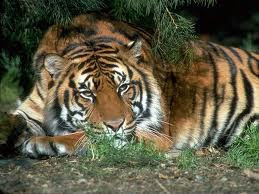South China tigers are a subspecies of tigers that can be found mainly in a very narrow area of south / south east China, mainly in forests.
South China tigers are not only one of the very endangered tiger species, but it is also considered to be THE one that is most likely to be extinct within a very short period if no real breeding and preservation efforts take place.
Experts estimate that the south China tiger population does not exceed two to three dozens only! This has earned it a ranking between the world’s top 10 animals that are on the verge of extinction � pretty sad.
What has mainly contributed to the reduction of the South Chinese tiger population is the amount of illegal hunting that was taking place in these southern forests, in addition to the reduction in the number of preys it can hunt (again, mostly due to humans).
These very tigers are now taking refuge in mountains within the area rather than open forests.
We have to also keep in mind that starting the 1960s, tigers were proclaimed a danger to humans in China, and as such hunting them down was taking place. This decision was reversed too late, almost two decades later. The South China tiger population had by then been reduced by more than 95%.
South China tigers (sometimes referred to as south Chinese tigers) are small in size, with the male ranging between 220 to 260 cm in length and around 140-170 kilograms in weight. Females are smaller in size (this is normal when it comes to tigers and similar mammals) with a length varying usually between 200 to 250 cm and a weight of around 120 kilograms. Their fur differs a bit from that of other subspecies, given that the stripes are somewhat thinner and more spaced along the body.
South China tigers are known for their patience and love for hunting. They would not get tired of spending several hours a day looking after preys. They also don’t mind attacking animals that are of equivalent weight if not more. But when it comes to hunger, they would settle down for anything, even small animals and insects.
If their prey is big, they try to suffocate it once they catch it, else they would simply attack lethally with their long teeth. They have no problem in attacking humans, and they have done many times in the past. So caution is required if one got to (ever) meet one in the wild.

No comments:
Post a Comment